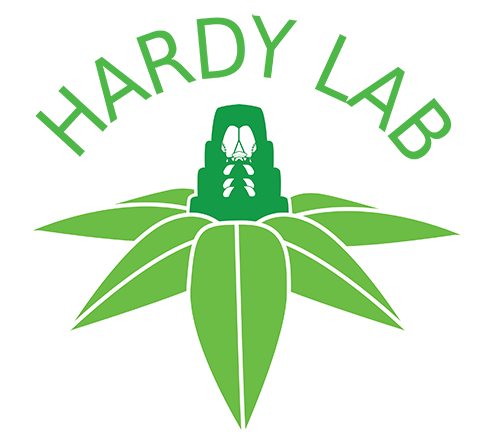Valid Names Results
Neotachardiella nangapire Kondo, Peronti & Pacheco da Silva, 2025 (Tachardiidae (= Kerriidae): Neotachardiella)Nomenclatural History
- Neotachardiella nangapire Kondo, Peronti & Pacheco da Silva 2025: 281. Type data: BRAZIL: Rio Grande do Sul, Passo Fundo, on Campomanesia xanthocarpa, 8/27/2011, coll. Alberto L. Marsaro Junior. Holotype, female, by original designation Type depository: Montevideo: Colección de Hexapoda de la Facultad de Ciencias, Universidad de la República, Montevideo, Uruguay.; Sáo Carlos, Departamento de Ecologia e Biologia Evolutiva da Universidade Federal de Sáo Carlos, Sáo Paulo, Brazil; accepted valid name Notes: Paratypes: BRAZIL: Rio Grande do Sul, Passo Fundo, on Psidium guajava, 7/27/2011, No. 842, 46/11, 5 adult females, coll. A.L. Marsaro Junior (FCE-HE) Illustr.
Common Names
- insecto laca de la pitanga KondoPaMa2025
- cochonilha laca da pitanga KondoPaMa2025
- pitanga fruit lac insect KondoPaMa2025
Ecological Associates
Hosts:
Families: 1 | Genera: 3
- Myrtaceae
- Campomanesia xanthocarpa | KondoPaMa2025
- Eugenia involucrata | KondoPaMa2025
- Eugenia uniflora | KondoPaMa2025
- Psidium guajava | KondoPaMa2025
Associates:
Families: 1 | Genera: 1
- Formicidae
- Camponotus mus | KondoPaMa2025
Geographic Distribution
Countries: 1
- Brazil
- Rio Grande do Sul | KondoPaMa2025
Keys
- KondoPaMa2025: pp.284 ( Adult (F) ) [Species of Neotachardiella]
Remarks
- Systematics: The adult female of N. nangapire most closely resembles that of N. ourinhensis. However, they are readily distinguishable by the shorter brachia and dorsal spine pedicel in N. nangapire. These structures are approximately equal in length to a single brachial plate, whereas in N. ourinhensis, they are roughly four times the length of a brachial plate. Furthermore, the resinous test of individual N. nangapire specimens typically exhibits 12 well-developed lobes, creating an appearance reminiscent of a pitanga fruit. In contrast, N. ourinhensis possesses poorly developed lobes, and its resinous test never resembles a pitanga fruit. (Kondo et al. 2025)
- Structure: Unmounted specimen: Resinous test orange to orange-brown, often appearing brown when covered in sooty mold; tests of adjacent females becoming fused when crowded on infested twigs and branches of host. Test of individual specimens (not fused) hemispherical, often with 12 well-developed marginal lobes, each lobe rounded, resembling a pitanga (E. uniflora) fruit; lobes fused in older specimens, which become almost spherical; first-instar test incorporated into adult test on mid-dorsum, inconspicuous; adult test also with a circular opening nearby on an elevated area just posterior to first-instar test. Slide-mounted specimen: Adult female broadly pyriform, often with a constriction at level of anterior stigmatic areas. Body 1.0–3.2 mm long, 1.0–3.3 mm wide. (Kondo et al. 2025)
- Economic Importance: This scale insect causes direct damage to the host plants by extracting the phloem sap. Infestations of the scale insect have been observed exclusively on branches. Because of their feeding, the scale insects excrete a substantial amount of honeydew, leading to growth of sooty molds (Capnodium spp.). In cases of heavy infestations, apical branches have been observed to become defoliated and desiccated or dead (Kondo et al. 2025).
- General Remarks: Description and illustration by Kondo et al. (2025).
Illustrations
Citations
- KondoPaMa2025: description, diagnosis, distribution, host, illustration, key, taxonomy, 281


